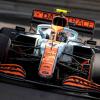But how practical is all of that?
Using Brembo Braking data from last season, provided by member wrcva, I have made some basic calculations.
Braking power is more than sufficient to provide the 2MJ per lap. However, the limitations that recovery occurs only on the rear wheels and the aloowable recovery power of 120kW severely limit this.
From the data I assumed 60% front, 40% rear braking bias. I am not sure how that relates to reality. Based on the average braking power I calculated the rear braking power. For braking power greater than 120kW the energy recovered was 120kW multiplied by the braking time, otherwise it was the braking power multiplied by the braking time. The latter case is essentially the MGU-K providing all of the rear braking effort.
The recovered energy, in kJ, is:
Circuit Energy SINGAPORE 2460 ABUDHABI 1846 AUSTIN 1567 BAHRAIN 1504 MONACO 1517 MALAYSIA 1463 KOREA 1349 HUNGARY 1284 SPA 1292 CHINA 1216 NURBURGRING 1171 CANADA 1159 CATALUNYA 1138 BRAZIL 1064 INDIA 1064 SUZUKA 1061 AUSTRALIA 992 MONZA 938 SILVERSTONE 730Clearly, only at Singapore is the braking energy recovery allowance exceeded. For all others the total is less.
Assuming that the MGU-H does not contribute to filling the ES, the amount of time the MGU-K can be run, per lap, on the recovered energy is:
Circuit Time SINGAPORE 16.67 ABUDHABI 15.38 AUSTIN 13.06 BAHRAIN 12.53 MONACO 12.64 MALAYSIA 12.19 KOREA 11.24 HUNGARY 10.7 SPA 10.77 CHINA 10.13 NURBURGRING 9.76 CANADA 9.66 CATALUNYA 9.48 BRAZIL 8.87 INDIA 8.87 SUZUKA 8.84 AUSTRALIA 8.27 MONZA 7.82 SILVERSTONE 6.08But at least some of that time will be as the MGU-H is also supplying the MGU-K. Based on the Cosworth data posted in the 2014 Power Unit Thread, the MGU-H gives the MGU-K around 110hp above 10,500rpm. That means the ES has to supply 50hp/37kW.
Circuit Time SINGAPORE 53.62 ABUDHABI 49.48 AUSTIN 42.01 BAHRAIN 40.31 MONACO 40.68 MALAYSIA 39.22 KOREA 36.17 HUNGARY 34.42 SPA 34.64 CHINA 32.59 NURBURGRING 31.4 CANADA 31.08 CATALUNYA 30.5 BRAZIL 28.54 INDIA 28.54 SUZUKA 28.44 AUSTRALIA 26.61 MONZA 25.16 SILVERSTONE 19.56In many of these circuits time at full power will be less than that, and the ES will contribute a higher amount of power to the mix.
The theory of saving your energy to be able to mount a passing attempt will require 3 or more laps for most circuits to gain the 4MJ maximum.
Silverstone would be the most likely track to use such a strategy. Less is lost by not applying the power on the track on which it was recovered, and more is gained when using the extra power. It would, however, take 5.5 laps to gain the full 4MJ energy. It may be that the driver would not actually use the energy to pass on track, but to conserve his tyres and use the extra power/speed to try to leap frog his opponent in the pit stop phase.
The other side of this is the ES storage capacity. I am not sure that a full 4MJ capacity is possible within the 20-25kg weight band.
A little disappointed that there is a minimum weight for the ES. I would think that some teams would figure on not actually having much storage, using the energy shortly after it is recovered (the maximum single corner recovery is ~370kJ in Abu Dhabi) and saving 5-10kg that could be the difference between being overweight or right on the weight.
EDIT: Corrected the calculated numbers. Some of the values were from a previous calculation where I had disregarded the power of the rear brakes is it was below 120kW.
Edited by Wuzak, 07 February 2014 - 03:26.
























